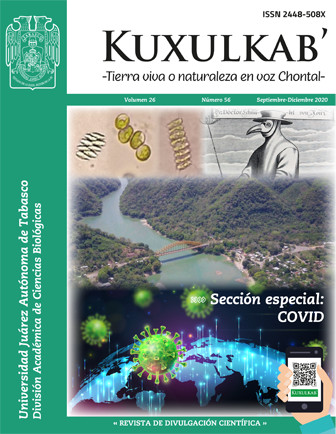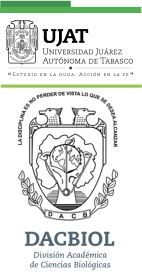VILLAHERMOSA-TABASCO WIND CHARACTERIZATION DURING 2008-2018
DOI:
https://doi.org/10.19136/kuxulkab.a26n56.3500Keywords:
ENSO, Componentes de viento, Rosa de vientos, EstacionalidadAbstract
This work focuses on the characterization of the winds that cross the city of Villahermosa, Tabasco, through the wind roses analysis from 2008 to 2018. The annual and quarterly graphs of the data obtained from the Comisión Nacional del Agua were analyzed. The results show that the dominant direction of the winds is from the East, which is associated with the low-level Jet present throughout the year. Secondary winds are associated with the different phenomena that predominate in the Gulf of Mexico, as is the case with the Alisios Winds and ‘Nortes’ in winter, while in summer, the components are associated with phenomena of ‘ Las Ondas del Este’. On the other hand, the study shows that El Niño-Southern Oscillation activity may influence the presence of other components.
Downloads
References
Aguilar Rojas, G. & Iza, A. (2009). Gobernanza de aguas compartidas: aspectos jurídicos e institucionales, (Serie de Política y Derecho Ambiental numero 58 rev.; p. 240). Gland; Suiza: Unión Internacional para la Conservación de la Naturaleza (UICN). Recuperado el 29 de abril del 2020 de «https://www.iucn.org/sites/dev/files/import/downloads/eplp_58_ref_pdf.pdf»
Carslaw, D.C. (2019). The openair manual open-source tools for analysing air pollution data, (Manual for versión 2.6-6; p. 224). University of York and Ricardo Energy & Environment. Recovered from «https://davidcarslaw.com/files/openairmanual.pdf»
Elliott, D.; Schwartz, M.; Scott, G.; Haymes, S.; Heimiller, D. & George, R. (2004). Atlas de Recursos Eólicos del Estado de Oaxaca, (versión traducida con apoyo de Winrock International a solicitud de la Secretaría de Desarrollo Industrial y Comercial (SEDIC) del Gobierno del Estado de Oaxaca, en coordinación con el National Renewable Energy Laboratory (NREL); p. 138). Recuperado de «http://www.nrel.gov/docs/fy04osti/35575.pdf»
Flores-Vidal, X.; Durazo, R.; Chavanne, C. & Flament, P. (2011). Coastal circulation in the absence of wind in the Gulf of Tehuantepec, Mexico: High-frequency radar observations. Ciencias Marinas, 37(4A): 493-512. DOI «http://dx.doi.org/10.7773/cm.v37i4A.1911»
Jáuregui Ostos, E. (1975). Los sistemas de tiempo en el Golfo de México y su vecindad. Investigaciones Geográficas, 1(6):7-36. DOI «https://doi.org/10.14350/rig.58888»
Jáuregui Ostos, E. (2003). Algunos conceptos modernos sobre la circulación general de la atmósfera. Investigaciones geográficas, (50): 121-143. Recuperado de «http://www.scielo.org.mx/scielo.php?script=sci_arttext&pid=S0188-46112003000100012&lng=es&tlng=es»
Llanos Arias, J. & Cervantes Pérez, J. (1995). Vientos máximos en el estado de Veracruz. La ciencia y el hombre, (21): 185-208. Recuperado de «http://cdigital.uv.mx/handle/123456789/5335»
Magaña, V.; Pérez, J.L. & Conde, C. (1998). El fenómeno de ‘El Niño’ y la oscilación del Sur: sus impactos en México. Ciencias, (51): 14-18. Recuperado de «https://www.revistacienciasunam.com/images/stories/Articles/51/CNS05103.pdf»
Magaña, V.O.; Vázquez, J.L.; Pérez, J.L. & Pérez, J.B. (2003). Impacto of ‘El Niño’ on precipitation in Mexico. Geofísica Internacional, 42(3): 313-330. Recuperado de «https://www.redalyc.org/pdf/568/56842304.pdf»
Muñoz, E.; Busalacchi, A.; Nigam, S. & Ruiz-Barradas, A. (2008). Winter and Summer Structure of the Caribbean Low-Level Jet. Journal of Climate, 21(6): 1260-1276. DOI «https://doi.org/10.1175/2007JCLI1855.1», «https://journals.ametsoc.org/downloadpdf/journals/clim/21/6/2007jcli1855.1.xml»
NOAA (National Oceanic and Atmospheric Administration). (2019). National Weather Service, NOAA [Web]. Consulted in «https://www.weather.gov/fwd/indices»
Orellana, R.; Nava, F. & Espadas, C. (2008). El clima de Cozumel y la Riviera Maya. En: Mejía-Ortíz, L.M. (Ed.), Biodiversidad acuática de la isla de Cozumel, (pp. 23-32). Quintana Roo; México: Universidad de Quintana Roo; Plaza y Valdés. Recuperado de «https://www.researchgate.net/publication/284899592_El_clima_de_Cozumel_y_la_Riviera_maya»
Papin, P.P.; Bosart, L.F. & Torn, R.D. (2017). A Climatology of Central American Gyres. Monthly Weather Review, 145(5): 1983-2000. DOI «https://doi.org/10.1175/MWR-D-16-0411.1», «https://www.researchgate.net/publication/314275039_A_Climatology_of_Central_American_Gyres»
R Core Team. (2019). R: A language and environment for statistical computing. R Foundation for Statistical Computing [Web], Vienna, Austria. Available online at «https://www.R-project.org/»
RStudio Team. (2020). RStudio: Integrated Development for R. RStudio, PBC, Boston, MA. «http://www.rstudio.com/»
Tapanes, J.J. & González-Coya, F. (1980). Hidrometeorología del Golfo de México y Banco de Campeche. Geofísica Internacional, 19(4): 335-354. Recuperado de «http://www.revistas.unam.mx/index.php/geofisica/article/view/39218»
Downloads
Published
Issue
Section
License
Copyright (c) 2020 Kuxulkab

This work is licensed under a Creative Commons Attribution-NonCommercial-ShareAlike 4.0 International License.
Los autores que publiquen en Kuxulkab' aceptan las siguientes condiciones como política de acceso abierto:
1. Que conservan los derechos de autor y ceden a la revista el derecho de la primera publicación, con el trabajo registrado con la licencia de atribucion de "Creative Commons", que permite a terceros utilizar lo publicado siempre que mencionen la autoría del trabajo y a la primera publicación en esta revista.
2. El autor puede realizar otros acuerdos contractuales independientes o adicionales para la distribución no exclusiva de la versión del artículo publicado en esta revista, como por ejemplo incluirlo en un repositorio institucional o publicarlo en un libro, siempre que se indique claramente que el trabajo se publicó por primera vez en esta revista.












